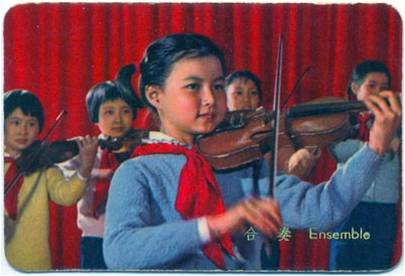Illustration:
ill. 1.9
Date:
1973
Genre:
calendar, image
Material:
internet file, colour; original source: photograph, colour, print on paper, calendar
Source:
DACHS 2009 Propaganda Posters, Maopost.com (edited by Pierre-Loic Lavigne and Pierre Budestschu) C00611, Heidelberg catalogue entry
Courtesy:
Pierre Lavigne
Inscription:
合奏
Keywords:
calendar girl, violin, music, musical intrument, foreign music, bourgeois, children, restriction, Western instrumental traditions, Cultural Revolution
Ensemble (Hezou 合奏)

Isaac Stern is invited to China by the Chinese government in the late 1970s on a concert and teaching tour that allowed for the production of the documentary From Mao to Mozart in June 1979. In its voice-over and in some of the discussions in which Stern participates, the film takes up the destructive influence of the Great Proletarian Cultural Revolution on musical practice and production in China.
The discourse Stern is confronted with is dismal: there was no music during the Cultural Revolution: classical musicians were not allowed to practice their instruments. The Cultural Revolution is presented in a well-familiar trope: it was a period of “cultural stagnation”. This open discourse is somewhat subverted by the film’s ever-present musical footage: it was made in June 1979, not even three years after the end of the Great Proletarian Cultural Revolution. And indeed, it is not all that difficult to find people who lived through the Cultural Revolution and tell a different story: this children’s string ensemble which decorates a 1973 calendar is one more example for this practice in place (see ill. I.2).





















